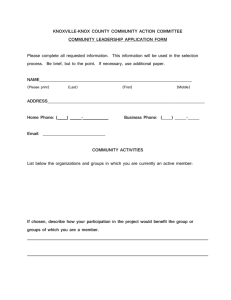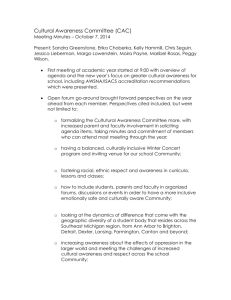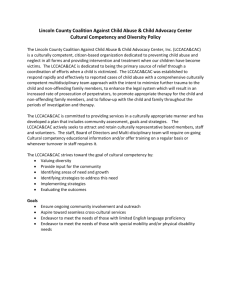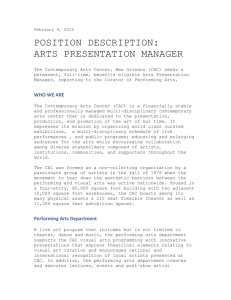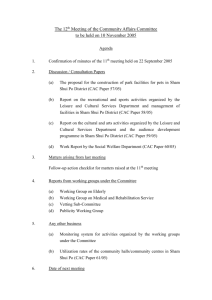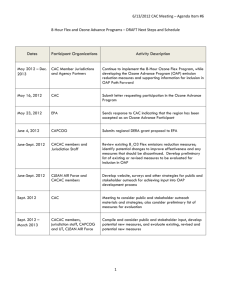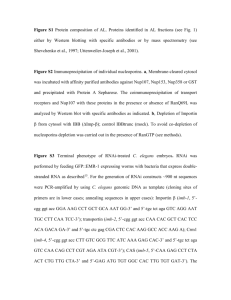Standards for Accreditation
advertisement
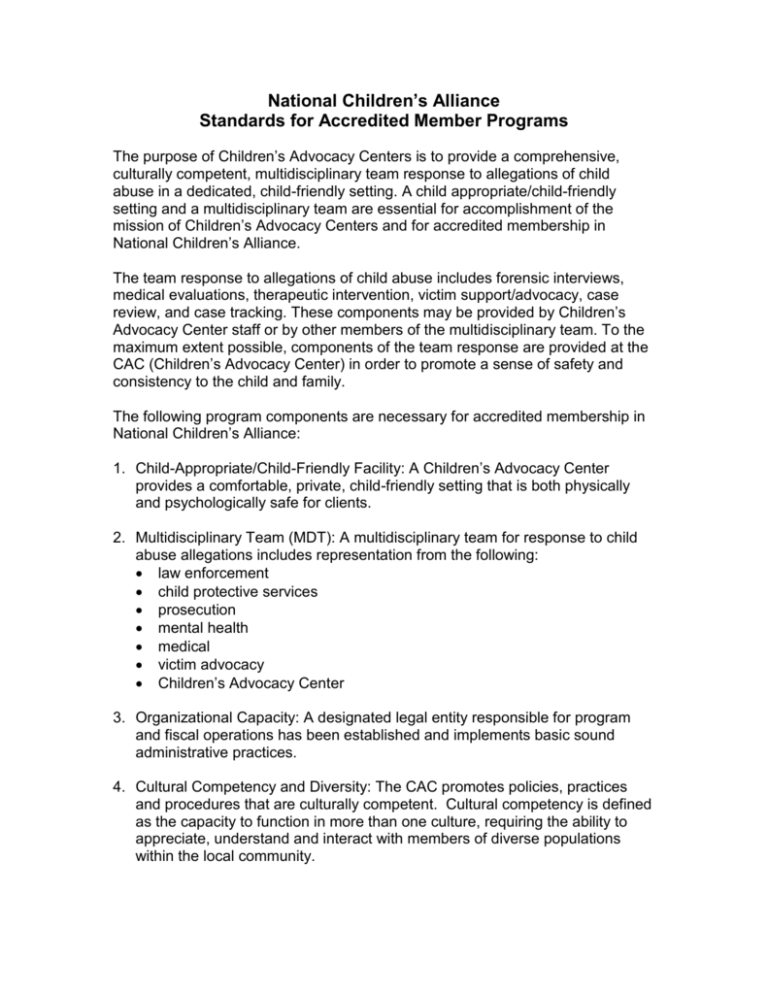
National Children’s Alliance Standards for Accredited Member Programs The purpose of Children’s Advocacy Centers is to provide a comprehensive, culturally competent, multidisciplinary team response to allegations of child abuse in a dedicated, child-friendly setting. A child appropriate/child-friendly setting and a multidisciplinary team are essential for accomplishment of the mission of Children’s Advocacy Centers and for accredited membership in National Children’s Alliance. The team response to allegations of child abuse includes forensic interviews, medical evaluations, therapeutic intervention, victim support/advocacy, case review, and case tracking. These components may be provided by Children’s Advocacy Center staff or by other members of the multidisciplinary team. To the maximum extent possible, components of the team response are provided at the CAC (Children’s Advocacy Center) in order to promote a sense of safety and consistency to the child and family. The following program components are necessary for accredited membership in National Children’s Alliance: 1. Child-Appropriate/Child-Friendly Facility: A Children’s Advocacy Center provides a comfortable, private, child-friendly setting that is both physically and psychologically safe for clients. 2. Multidisciplinary Team (MDT): A multidisciplinary team for response to child abuse allegations includes representation from the following: law enforcement child protective services prosecution mental health medical victim advocacy Children’s Advocacy Center 3. Organizational Capacity: A designated legal entity responsible for program and fiscal operations has been established and implements basic sound administrative practices. 4. Cultural Competency and Diversity: The CAC promotes policies, practices and procedures that are culturally competent. Cultural competency is defined as the capacity to function in more than one culture, requiring the ability to appreciate, understand and interact with members of diverse populations within the local community. 5. Forensic Interviews: Forensic interviews are conducted in a manner which is of a neutral, fact finding nature, and coordinated to avoid duplicative interviewing. 6. Medical Evaluation: Specialized medical evaluation and treatment are to be made available to CAC clients as part of the team response, either at the CAC or through coordination and referral with other specialized medical providers. 7. Therapeutic Intervention: Specialized mental health services are to be made available as part of the team response, either at the CAC or through coordination and referral with other appropriate treatment providers. 8. Victim Support/Advocacy: Victim support and advocacy are to be made available as part of the team response, either at the CAC or through coordination with other providers, throughout the investigation and subsequent legal proceedings. 9. Case Review: Team discussion and information sharing regarding the investigation, case status and services needed by the child and family are to occur on a routine basis. 10. Case Tracking: CACs must develop and implement a system for monitoring case progress and tracking case outcomes for team components. An important note about criteria rating: Some of the criteria have been determined to be absolutely necessary to the model of a Children’s Advocacy Center. These criteria have been designated as essential components and have been noted as such beneath the body of the standard. Other criteria will be rated by the quality of the manner in which the criteria is met. NCA recognizes that it is highly unlikely that any single CAC will meet all of the criteria in a way that is ever 100% perfect. In fact, the beauty of the CAC model is the creative way in which CACs have interpreted the criteria that makes a CAC and implemented these concepts to fit their community’s unique needs. Factors such as size, community resources, access to funding, geography, and population size are obviously considerations for CACs and their ability (or desire) to meet these criteria. These factors need not stand in the way of NCA membership. A commitment to setting standards and improving practice does not diminish NCA’s recognition of creativity in the implementation of these standards. The NCA Standards for Membership technical assistance manual, “Putting Standards into Practice: A Guide to Implementing NCA Standards for Children’s Advocacy Centers,” provides an explicit explanation of each standard and its criteria along with examples of how a divergent representation of CACs have met these criteria. NCA recognizes that some of the criteria listed under the standards for membership may be neither necessary nor possible for a particular CAC for varying reasons. For example, professional liability insurance may not be needed for government sponsored agencies. The application will include an “exceptions” format for applicants to explain why a criterion cannot be met in the way it is requested. Corollary Services Children’s Advocacy Centers may provide services in addition to the required program components listed previously provided that such corollary services are compatible with, and supportive of, the Children’s Advocacy Center mission. Core program components must take priority, however, over corollary services. While services for adult offenders may be part of a comprehensive response, such services may not be provided on-site at accredited member Children’s Advocacy Centers. On-site provision of services for adult offenders is not viewed as compatible with the primary mission of physical and psychological safety for child clients, unless a plan for complete separation of children and alleged offenders is clearly articulated and adhered to. Child-Appropriate/Child-Friendly Facility Standard: A Children’s Advocacy Center provides a comfortable, private, childfriendly setting that is both physically and psychologically safe for diverse populations of children and their families. Criteria: Essential Components A. The CAC is designed to provide complete separation of victims and alleged offenders to the maximum extent possible. B. Facility allows for interviews to be observed by team members while interview is taking place. Rated Criteria C. CAC is maintained in a manner which is physically safe and “child proof” for children of all ages. D. Children and families can be observed or supervised by staff/volunteers/team members at all times. E. Separate and private area(s) are available for case consultation and discussion, meetings with family members, and waiting areas. F. CAC provides access to materials and toys that reflect the needs and interests of the diverse population of children served. G. The CAC setting reflects the social, cultural, and ethnic makeup of the community served. H. The location of the CAC is convenient to clients and team members to the maximum extent possible. I. The CAC makes reasonable accommodations to make the facility physically accessible for children and their families. Multidisciplinary Team Standard: A multidisciplinary team for response to child abuse allegations includes representation from the following: law enforcement child protective services prosecution mental health medical victim advocacy Children’s Advocacy Center. Criteria: Essential Components A. The CAC has written agreements, protocols, and/or guidelines signed by authorized representatives of all team components. B. All members of the multidisciplinary team including appropriate CAC staff, as defined by the needs of the case, are routinely involved in investigations and/or team intervention. C. The CAC has implemented procedures for routine sharing of information among team members. Rated Criteria D. The CAC provides routine opportunity for the multidisciplinary team members to provide feedback and suggestions regarding procedures/operations of agency. E. The CAC provides opportunities for members of the multidisciplinary team to receive on-going and relevant cross-discipline training. Organizational Capacity Standard: A designated legal entity responsible for program and fiscal operations has been established and implements basic sound administrative practices. Criteria: Essential Components A. The CAC has general and professional liability coverage for all CAC staff, volunteers, and clients. B. The CAC is an incorporated, private non-profit organization or governmentbased agency or a component of such an organization or agency. C. The CAC has personnel responsible for coordinating its program components. D. The CAC has screening policies for volunteers that comply with state laws and provides training and supervision. E. The CAC has screening policies for staff that comply with state laws and provides training and supervision. F. The CAC supports a policy of broad representation of the whole community and actively recruits staff, volunteers, and board members that reflect the demographics of the community. G. The CAC has written confidentiality policies and procedures for the multidisciplinary team that insures client privacy but allows the sharing of relevant information consistent with legal, ethical, and professional standards of practice. Rated Criteria H. The CAC has written administrative policies and procedures. I. The CAC provides education on child abuse issues and outreach to the diverse groups reflecting the makeup of the CAC community. J. The CAC has addressed continuation of the program by development of fiscal projections and/or a funding plan. Cultural Competency and Diversity Standard: The CAC promotes policies, practices and procedures that are culturally competent. Cultural competency is defined as the capacity to function in more than one culture, requiring the ability to appreciate, understand and interact with members of diverse populations within the local community. Criteria: Essential Components A. The CAC’s written administrative policies and procedures include a statement on non-discrimination. B. The CAC provides opportunities for team members and staff to receive on-going training in diversity issues including ethnicity, gender, disabilities, sexual orientation, religion and culture. C. The CAC must have provisions for non-English-speaking children and family members throughout the investigation process, medical exam, and follow-up services provided at the CAC. Rated Criteria D. The CAC provides opportunities for MDT members throughout the case management process to ensure that cross-cultural issues are addressed. E. Culturally appropriate mental health services should be made available as part of the team response or through coordination with other providers. F. The CAC provides community outreach to traditionally underserved populations. Forensic Interviews Standard: The CAC promotes forensic interviews which are legally sound, are of a neutral, fact finding nature, and are coordinated to avoid duplicative interviewing. Criteria: Essential Components A. The MDT/CAC has written guidelines or agreements that describe the general interview process, including pre- and post-interview information sharing and decision-making, and interview procedures. B. The CAC promotes forensic interviews which are legally sound: non-duplicative, non-leading, and neutral. C. The CAC has a setting that allows team members to observe interviews and to communicate with the interviewer during the interview. D. Team interviews include participation by all team members with investigative responsibilities in each case. Rated Criteria E. Team interviews are routinely conducted at the CAC. F. The team’s written guidelines or agreement includes: selection of an appropriate, trained interviewer; sharing of information among team members; and a mechanism for collaborative case planning. G. The CAC and/or team provides opportunities for professionals who conduct forensic interviews to receive specialized training. H. The CAC promotes investigative interviews that are developmentally appropriate. I. The CAC promotes investigative interviews that are culturally competent. Medical Evaluation Standard: Specialized medical evaluation and treatment services are available to all CAC clients and coordinated with the multidisciplinary team response to provide follow-up referrals and/or treatment as necessary. Criteria: Essential Components A. Medical evaluations are provided by health care providers with pediatric experience and child abuse expertise at the CAC or through the CAC’s affiliation with an appropriate facility. B. Specialized medical evaluations are available and accessible to all CAC clients regardless of ability to pay. C. The team’s written protocols and agreements include access to appropriate medical evaluation and treatment for all CAC clients. Rated Criteria D. The team’s written protocols and agreements include: the circumstances under which a medical evaluation is recommended; the purpose of the medical exam; how the medical evaluation is made available (scheduling, linkage with providers, triage); how emergency situations are addressed; how multiple examinations are avoided; forensic documentation and collection and preservation of evidence; how the medical evaluations is coordinated with the MDT in order to avoid duplication of interviewing and history-taking; procedures for medical intervention in cases of suspected physical abuse and maltreatment, if applicable. the role of the health care provider on the MDT including case tracking and review; provision for attendance by a health care provider at case review; and provisions regarding sharing relevant information with the team while protecting the client’s right to confidentiality. E. Team members and CAC staff are trained regarding the purpose and nature of the evaluation and educate clients and/or non-offending caregivers regarding the medical evaluation. F. Findings of the medical evaluation are shared with investigators and prosecutors on the MDT in a routine and timely manner. Therapeutic Intervention Standard: Specialized mental health services must be made available as part of the team response either at the Children’s Advocacy Center or through coordination with other treatment providers. Criteria: Essential Components A. Mental health services for the child client are routinely made available on-site or through linkage agreements with other appropriate agencies or providers. B. Mental health services are available and accessible regardless of ability to pay. C. The team’s written protocols and agreements include access to appropriate mental health evaluation and treatment for all CAC clients. Rated Criteria D. The team’s written protocols and agreements include: the role of the mental health professional on the MDT including case tracking and review; provision for attendance by a mental health professional at case review; and provisions regarding sharing relevant information with the team while protecting the client’s right to confidentiality. E. If therapy is provided on-site, space is available that is private and sensitive to the child’s development. F. Mental health services for non-offending family members and/or caregivers are routinely made available on-site or through linkage agreements with other appropriate agencies or providers. G. The forensic interview or assessment is separate from mental health treatment. Victim Support/Advocacy Standard: Victim support and advocacy are to be available throughout the investigation and prosecution. Criteria: Essential Components A. The availability of victim support and advocacy services is included in the team’s written protocol or agreement. B. Crisis intervention and support are routinely available throughout the investigation and prosecution. C. Client education regarding investigation, prosecution, and treatment is routinely available throughout the investigation and prosecution. D. Information regarding the rights of a crime victim and local services is routinely available to all clients. Rated Criteria E. Designated, trained individuals provide victim support/advocacy on-site and/or through linkage with other service agencies including, but not limited to: court preparation; court accompaniment; crime victims compensation; and assistance with access to services such as protective orders, housing, public assistance, domestic violence intervention, and transportation. F. Procedures are in place to provide periodic follow-up contact with the child and/or non-offending caregiver(s) including on-going information about civil and criminal legal proceedings. Case Review Standard: Team discussion and information sharing regarding the investigation, case status and services needed by the child and family is to occur on a routine basis. Criteria: Essential Components A. Criteria for case review and case review procedures are included in the team’s written protocol or agreement. B. A forum for the purpose of reviewing cases is conducted on a regularly scheduled basis. Rated Criteria C. An individual is identified to coordinate the case review process, and team members are informed of cases to be reviewed prior to case review. D. Team representatives participating in case review include, at a minimum: law enforcement; prosecution; child protective services; medical; mental health; victim advocacy; and children’s advocacy center. E. Recommendations from case review are communicated to appropriate parties for implementation. F. Case review meetings are utilized as an opportunity for team members to increase understanding of the complexity of child abuse cases. Case Tracking Standard: Children’s Advocacy Centers must develop and implement a system for monitoring case progress and tracking case outcomes for all team components. Criteria: Essential Components A. Cases are tracked routinely as a part of the team protocol while the case is pending in the child protective and criminal justice system. B. The CAC has a mechanism to track and retrieve case information including: client demographics, including: age, ethnicity, disability, and gender; case outcome; and NCA statistical information. Rated Criteria C. An individual is identified to implement the case tracking process. D. Team protocols and agreements address case tracking criteria and procedures. E. Team members have access to tracking information.
